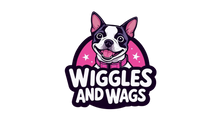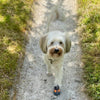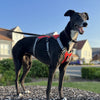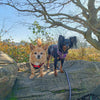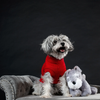How To Toilet Train Your Dog - From Puppy To Adult

I don't think it's ever too late to toilet train your dog. In fact, I don't think it is too late to train your dog to do anything, whether it's a puppy or an adult dog.
Sure, dogs of all shapes, sizes, breed and age can get into bad habits (and that includes toilet training), but that doesn't mean they can't be eradicated. The trick with all of this is to teach your dog a behaviour it can match to a positive response, communication, praise and reward.
For some, the reward can be a toy and for others it will be a food treat. Either way, training of any description will only enhance the relationship you have with your dog, so why not get into toilet training right from the puppy stage. It is such a great place to start your training regime and you'll see a difference in how your dog reacts and behaves in no time.
When it comes to toilet training your puppy it is all about getting into a routine. A puppy will usually want to pee within a few minutes of waking up so it is a good idea to be around as much as possible. Of course you can't be there at all times and it goes without saying that you'll have a tough job preventing your dog from urinating or defecating indoors every single time.
If your puppy or dog goes to the toilet indoors don't react harshly or cause a fuss. If you do, this can sometimes stop your dog from wanting to go to the toilet in front of you and this can include outside.However, it is a good idea to get into the routine of taking your dog outside when it wants to go to the toilet so it knows that is where to do its business. Ideally, you should do this once every hour, especially if you are training a puppy. Puppies can also urinate without warning if they have been very active so a quick visit outside following play is a good idea.
So, if an accident occurs, just clean it up and accept it. And if you do need to clean up the mess indoors don't use cleaning products with ammonia in them. This has a similar smell to urine and it can actually cause the dog to do the same again in the same place.
When you do take your dog outside think of a word which means "go to the toilet." Something we use is "go busy" and we use this every time we want our dogs to go outside and do their business. In our case, these two words are short, simple to understand and don't sound like any other words we use as commands or for obedience training.
As soon as your dog goes to the toilet outside, reward it. You can also go a stage further and try to get your dog to "go busy" in the same area of the garden. If you have an area of gravel or stones then this is a good place. Dogs are creatures of habit and they can learn to go in the same place very quickly. Of course repetitive peeing on grass turns it yellow so this is why we recommend a non grass surface if you can. This takes a bit of training but it is possible.
If you want your dog to go to the toilet when out on walks you need to make it OK for them to do so. Try to time your walk as early as you can before the dog's first pee or poo.
Again, use your buzz word and reward the dog if it goes to the toilet when out on a walk. If it doesn't do it's business try to stay out as long as you can until it does. If it still doesn't, make sure you get it into the garden as quickly as possible on your return, as it could be desperate to go and may do so indoors if you are not quick enough.
Remember, try to stick to a routine and be consistent at all times. This includes the times you feed the dog and try not to include too much salt in their diet. Salty foods and treats will usually make your dog drink more and this means it will pee more.
For older dogs the same applies. Sometimes this can be a little more difficult, depending on different circumstances and what experiences the dog has gone through in the past.
If you have taken in an older dog or one from a rescue, they may have ingrained behavioural patterns and this can take you a bit more time to get them out of it. You will have no real idea of what this dog has experienced so always be patient, calm and try not to react to any accidents in a loud or aggressive way.
Regular routines of showing and teaching the dog that they should be going to the toilet outdoors should pay off, but if you find that your dog displays unusual behaviour or a level of incontinence, make sure that you have your dog checked out by your vet to rule out any infection or other medical condition.
Sure, dogs of all shapes, sizes, breed and age can get into bad habits (and that includes toilet training), but that doesn't mean they can't be eradicated. The trick with all of this is to teach your dog a behaviour it can match to a positive response, communication, praise and reward.
For some, the reward can be a toy and for others it will be a food treat. Either way, training of any description will only enhance the relationship you have with your dog, so why not get into toilet training right from the puppy stage. It is such a great place to start your training regime and you'll see a difference in how your dog reacts and behaves in no time.
When it comes to toilet training your puppy it is all about getting into a routine. A puppy will usually want to pee within a few minutes of waking up so it is a good idea to be around as much as possible. Of course you can't be there at all times and it goes without saying that you'll have a tough job preventing your dog from urinating or defecating indoors every single time.
If your puppy or dog goes to the toilet indoors don't react harshly or cause a fuss. If you do, this can sometimes stop your dog from wanting to go to the toilet in front of you and this can include outside.However, it is a good idea to get into the routine of taking your dog outside when it wants to go to the toilet so it knows that is where to do its business. Ideally, you should do this once every hour, especially if you are training a puppy. Puppies can also urinate without warning if they have been very active so a quick visit outside following play is a good idea.
So, if an accident occurs, just clean it up and accept it. And if you do need to clean up the mess indoors don't use cleaning products with ammonia in them. This has a similar smell to urine and it can actually cause the dog to do the same again in the same place.
When you do take your dog outside think of a word which means "go to the toilet." Something we use is "go busy" and we use this every time we want our dogs to go outside and do their business. In our case, these two words are short, simple to understand and don't sound like any other words we use as commands or for obedience training.
As soon as your dog goes to the toilet outside, reward it. You can also go a stage further and try to get your dog to "go busy" in the same area of the garden. If you have an area of gravel or stones then this is a good place. Dogs are creatures of habit and they can learn to go in the same place very quickly. Of course repetitive peeing on grass turns it yellow so this is why we recommend a non grass surface if you can. This takes a bit of training but it is possible.
If you want your dog to go to the toilet when out on walks you need to make it OK for them to do so. Try to time your walk as early as you can before the dog's first pee or poo.
Again, use your buzz word and reward the dog if it goes to the toilet when out on a walk. If it doesn't do it's business try to stay out as long as you can until it does. If it still doesn't, make sure you get it into the garden as quickly as possible on your return, as it could be desperate to go and may do so indoors if you are not quick enough.
Remember, try to stick to a routine and be consistent at all times. This includes the times you feed the dog and try not to include too much salt in their diet. Salty foods and treats will usually make your dog drink more and this means it will pee more.
For older dogs the same applies. Sometimes this can be a little more difficult, depending on different circumstances and what experiences the dog has gone through in the past.
If you have taken in an older dog or one from a rescue, they may have ingrained behavioural patterns and this can take you a bit more time to get them out of it. You will have no real idea of what this dog has experienced so always be patient, calm and try not to react to any accidents in a loud or aggressive way.
Regular routines of showing and teaching the dog that they should be going to the toilet outdoors should pay off, but if you find that your dog displays unusual behaviour or a level of incontinence, make sure that you have your dog checked out by your vet to rule out any infection or other medical condition.
